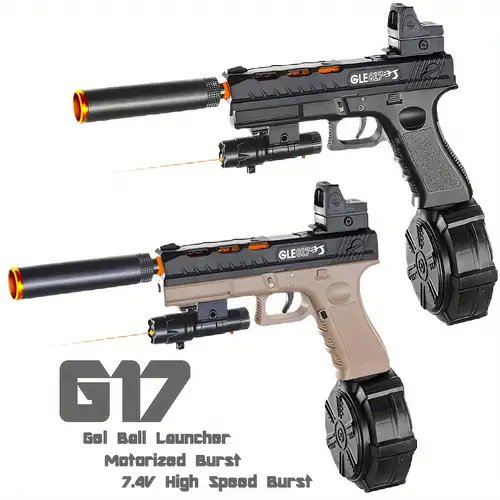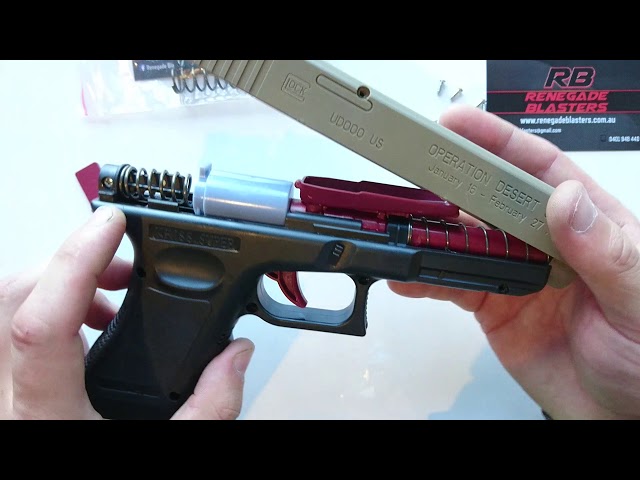Electric vs. Manual Gel Blasters: How Adult Players Can Choose2024-04-03
In recent years, gel blasters have emerged as an exciting hobby for adults seeking an adrenaline-fueled yet safe and responsible form of recreation. Whether you're a seasoned player or a newcomer to the world of gel ball warfare, choosing the right type of gel blaster can significantly impact your overall experience. With the availability of electric and manual options, it's essential to understand the nuances of each to make an informed decision that aligns with your preferences and playstyle.
The Basics of Electric Gel Blasters
How Electric Gel Blasters Work
Electric gel blasters run on rechargeable batteries and fire automatically. They have a hopper or magazine that continuously feeds gel balls into the firing chamber. With just a pull of the trigger, the electric motor rapidly cycles the action to fire multiple shots without manually reloading between each one.
Key Advantages
One major advantage of electric blasters is their incredibly high rate of fire. In fast-paced skirmish games, the ability to lay down a blistering stream of gel balls can be a game-changer. Many models let you adjust between semi-auto (firing once per trigger pull) or fully automatic firing modes.
Being battery-powered also makes electric blasters relatively lightweight and easy to maneuver during run-and-gun gameplay. The lack of manual reloading reduces user fatigue over extended sessions.
Best for Rapid-Fire Players
Electric gel blasters shine for players who prioritize a high volume of firing power and appreciate the convenience of automatic operation. They excel in intense close-quarters battles where sustained suppressive fire gives you an edge.
Those with limited hand strength or dexterity may also prefer electrics since there's minimal physical input required beyond pulling the trigger. No repetitive reloading actions mean reduced strain.

The Basics of Manual Gel Blasters
How Manual Gel Blasters Work
Manual gel blasters, also called springer or pump-action, rely on user input to power each shot. To fire, you have to manually cock or pump the blaster, usually by pulling back a bolt or pump handle. This action loads a gel ball into the chamber and compresses an internal spring or air reservoir to build up firing power.
Hands-On Satisfaction
A big draw of manual blasters is the hands-on, immersive experience they provide. Players get satisfying physical feedback from cycling the action - feeling and hearing that distinctive click or pump with each shot. This deliberate process heightens the connection between the shooter and the blaster.
Appeals to Traditionalists
Manual gel blasters tend to appeal most to players who appreciate the classic shooting experience that requires technique. There's skill involved in smoothly and efficiently cycling the action to rapidly re-chamber each shot.
They also appeal to those who enjoy the nostalgic feel reminiscent of old-school airsoft or paintball markers. The quieter operation of manual blasters can be advantageous for stealthy gameplay when you don't want to give away your position.
Electric vs Manual Gel Blasters: Side-by-Side Comparison
Rate of Fire
Electric blasters dominate for sheer firing speed, especially in fully automatic mode where they can spit out 10-15 gel balls per second. This high volume of fire gives a big advantage in close-quarters skirmishing where suppressing the enemy is key.
While manuals can't quite match that blistering pace, experienced users can still cycle the action rapidly to achieve decent 5-8 ball/second rates. But this takes considerable arm strength and dexterity compared to just holding a trigger down.
Reliability and Durability
With fewer moving parts, manual blasters tend to be more rugged and reliable, especially in harsh outdoor conditions. Properly maintained, the simple mechanical design can shrug off dirt, water, and drops that could disable an electric blaster's electronics or battery.
Electrics require more care to keep delicate components like motors, wiring, and batteries running smoothly. Parts may need replacing over time due to the higher operational stress.
Ease of Use
Out of the box, electric blasters have a shallower learning curve. Point and hold the trigger - the automated firing cycle does the rest. Mastering a smooth, rapid pump/reload action on a manual takes much more practice.
However, once that manual technique is learned, some players find the hands-on process more engaging than an electric's "point and click" simplicity. The skill barrier adds rewarding mastery.
Modifiability
Both electric and manual platforms offer plenty of customization potential for upgrade enthusiasts. Electrics can modify motors, batteries, flywheels, and electronic accessories.
Manuals are widely modded for different springs, bolts, barrels, and even 3D-printed components to tweak performance. The simpler design also allows for custom body kits and aesthetic modding.

Gameplay Practicality and Field Considerations
Game Scenarios
Electric blasters shine in close-quarter skirmishes and objective-based games where the volume of fire is crucial for area suppression and pushing through bottlenecks.
Meanwhile, manuals are better suited for large open fields and long-range engagements that call for measured, precise shooting and ammo conservation. Their stealthy operation also gives an edge in sneaky gameplay.
Weight, Maneuverability, and Stealth
A major practical advantage of manual blasters is being 20-30% lighter than comparable electrics. This trimmer weight makes them easier to wield for extended periods and in tight spaces.
Electrics feel front-heavy due to grips stuffed with batteries and motors. This extra bulk can fatigue arms faster and impede maneuvering in enclosed areas like indoor CQB sites.
The nearly silent operation of manually cycling rounds is also a big plus for stealthy gameplay and concealing your position.
Play Style Compatibility
It's wise to consider your local community's predominant playstyles too. If scenarios skew heavily toward rapid CQB action, electrics will be better matched. Whereas manuals sync up nicely if your field favors large authentic mil-sim-style ops requiring stealth and ammo management.
Choosing a platform compatible with your scene avoids being outmatched and ensures you'll fit into established gameplay.
Long-Term Considerations
Maintenance and Repair
Electric blasters require more frequent part replacements over time. Batteries may only last 1-2 years with heavy use. Motors, wiring, and circuit boards are also common failure points.
Proper cleaning and regrease of mechanical components like gearboxes is essential. This can get tedious compared to simple manual blaster maintenance.
For manuals, the main concern is periodically replacing worn springs that lose compression power. Quality upgrade springs can extend the interval between swaps.
Lubing moving parts and checking for air leaks is about all else manuals need. Their simple designs make DIY repairs easier too.
Ongoing Costs
With electrics, you're locked into continually buying costly LiPo battery packs every couple of years. Prices range from $20-60+ for quality ones.
Manuals avoid battery costs if non-pneumatic. But CO2 or compressed air canisters for pneumatic models add up over time, running $10-20 per disposable canister.
Either way, upgrade parts like reinforced nozzles, new barrels, or hop-up buckings factor into the lifetime cost equation.
Resale Value
Both platforms can retain decent resale value when well-maintained. But market demand varies by region.
In North America and Europe, high-end electrics from popular brands tend to move quickly on secondhand markets. Modded examples also appeal to tech enthusiasts.
Meanwhile, Asia sees a bigger appetite for collectible unique-bodied manual blasters with modding potential. Their simplicity is also prized in developing markets.
Personal Preference and Community Input
Comfort and Personal Fit
Ultimately, the choice between an electric or manual gel blaster should be guided by your personal preferences and what feels most comfortable and enjoyable for you. Factors such as grip ergonomics, weight distribution, and overall handling can significantly impact your gameplay experience.
Community Resources
To gather valuable insights and opinions, leverage community resources such as online forums, local gel blaster clubs, or experienced players in your area. Read reviews, watch gameplay videos, and engage with others to gain a better understanding of the pros and cons of each type of blaster.
Trial and Error
If possible, consider renting or borrowing different models of electric and manual gel blasters before making a purchase. This hands-on experience can provide invaluable feedback on what type best suits your playstyle and preferences. Many gel blaster communities or retailers may offer rental options or demo events to facilitate this trial-and-error approach.
Finding Your Ideal Gel Blaster Fit
Choosing between an electric or manual gel blaster ultimately comes down to personal preference and finding the right fit for your playstyle, comfort, and long-term needs. Electrics deliver unbeatable firing speed and ease of use, while manuals provide a hands-on, robust experience. Tap into your local community, try before you buy, and go with the platform that truly feels like an extension of yourself on the field. Don't compromise - explore your options until you find that perfect gel blaster companion to elevate your hobby excitement.
- Company Info
- About Us
- Contact Us
- Customer Reviews
- Blogs
- Brands
- YouTube Videos
- User Center
- FAQ
- Forget Password
- My Orders
- Tracking Order
- My Account
- Register
- Affiliate
- Company Policy
- Locations We Ship To
- Payment Methods
- Shipping Policy
- Refund Policy
- Privacy Policy
- Terms of Service
- Disclaimer
- Contact Us
ZHENDUO Electornics Technology LLC
Address: 7200 MISSOURI AVE,Denver,CO,United States,80202
Contact number: (626) 215-2450
Email address: xiewentao@zhenduo.email


